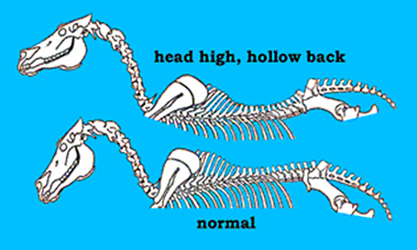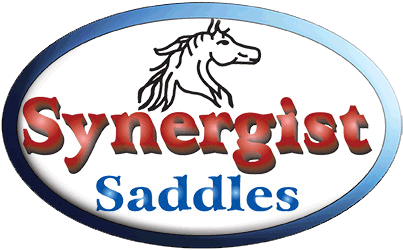What’s really going on with a hollow backed horse? We’ve seen quite a few horses over past years who appear just as any other horse when at liberty or standing but as soon as the rider is mounted and asks the horse to move forward, the head comes up and the middle of the back hollows out thus losing contact with the saddle. The medical term for this is ventroflexion but more commonly it’s often referred to as traveling inverted or upside-down. It all adds up to the same thing…trouble for your horse’s back.
 Riders will often ask us to purposely add more rock to the middle of the saddle so that it will fit when the horse moves off. We can do that but it’s not a good idea for the long term health and soundness of the horse. Look at the diagram of the hollow backed horse on the upper right of this page. The tops of the spinous processes (the spires of the top of the vertebrae), where muscles and ligaments attach, can come in contact with each other. Compare that to the normal horse where you can see the space between the individual processes. In addition, nerve roots that branch out from the spinal cord may become compressed and over time herniated disks may also develop. This happens when all or part of the soft center of a spinal disk is forced through a weakened part of the disk. The bottom line here is pain and an unhappy horse.
Riders will often ask us to purposely add more rock to the middle of the saddle so that it will fit when the horse moves off. We can do that but it’s not a good idea for the long term health and soundness of the horse. Look at the diagram of the hollow backed horse on the upper right of this page. The tops of the spinous processes (the spires of the top of the vertebrae), where muscles and ligaments attach, can come in contact with each other. Compare that to the normal horse where you can see the space between the individual processes. In addition, nerve roots that branch out from the spinal cord may become compressed and over time herniated disks may also develop. This happens when all or part of the soft center of a spinal disk is forced through a weakened part of the disk. The bottom line here is pain and an unhappy horse.
So how can we help our horse? Collection. We often hear the word collection in the horse world but the concept remains shrouded in mystery for a lot of people. I was giving a saddle fit demo at the Equine Affaire in Massachusetts and I asked the crowd if they had heard of the term collection. Nearly everyone there raised their hands. Then I asked how many could actually give me a simple, concise explanation of the term and only around 25% left their hands in the air.
Collection is nothing more than the rebalancing of the moving horse. The horse naturally carries 60-70% of his weight on the forehand. This becomes obvious when you consider the fact that the head and neck are in front of the front legs. The collected horse is taught and conditioned to be able to shift some of this weight off of the forehand by bending at the poll, lowering the head and engaging the hind quarters to be able to step more fully under the horse’s mass in order to carry the additional weight of the rider more efficiently. Collection is a process; it cannot be achieved overnight. It takes time to condition the neck, back and abdominal muscles that the horse uses to elevate his back and bring his hind end up underneath him. The hollow backed horse needs additional training to be able to properly carry the additional weight of the rider properly.
I won’t go into the actual specifics of the training involved because I am not a horse trainer and it would be beyond the scope of this article. However, there is a wealth of free information available on the Internet and many qualified trainers who can help you with learning the process which is essential for the long term health and continued soundness of the horse.

Comments 1
very great info!